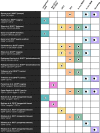HIV transmitting mononuclear phagocytes; integrating the old and new
- PMID: 35173293
- PMCID: PMC9259493
- DOI: 10.1038/s41385-022-00492-0
HIV transmitting mononuclear phagocytes; integrating the old and new
Abstract
In tissue, mononuclear phagocytes (MNP) are comprised of Langerhans cells, dendritic cells, macrophages and monocyte-derived cells. They are the first immune cells to encounter HIV during transmission and transmit the virus to CD4 T cells as a consequence of their antigen presenting cell function. To understand the role these cells play in transmission, their phenotypic and functional characterisation is important. With advancements in high parameter single cell technologies, new MNPs subsets are continuously being discovered and their definition and classification is in a state of flux. This has important implications for our knowledge of HIV transmission, which requires a deeper understanding to design effective vaccines and better blocking strategies. Here we review the historical research of the role MNPs play in HIV transmission up to the present day and revaluate these studies in the context of our most recent understandings of the MNP system.
© 2022. The Author(s).
Conflict of interest statement
The authors declare no competing interests.
Figures

References
Publication types
MeSH terms
LinkOut - more resources
Full Text Sources
Medical
Research Materials

